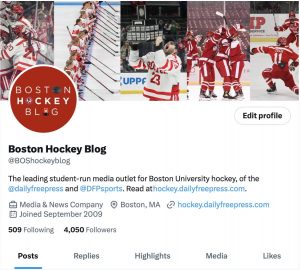Offense: A-
After mustering just five goals in their first three games combined, the Terriers doubled their season total by dropping a five-spot on UMass-Lowell tonight. Four of BU’s goals involved guys driving to the net, something that has been lacking for most of the season. The first two goals, scored by Alex Chiasson and David Warsofsky, came on odd-man rushes that were finished with snipes over River Hawk goalie Carter Hutton’s glove. On his second goal, BU’s fourth of the game, Warsofsky jumped into the play late and took a pass from Andrew Glass at the top of the slot, where he fired a wrister threw a screen and into the net. Colby Cohen’s overtime game-winner found its way through a slew of bodies blocking Hutton’s view. The Terriers still struggled to set up at times on offense, and coach Jack Parker noted that his team was outworked down low for much of the game, but it’s tough to find too much to complain about on the offensive side of things after tonight.
Defense: C-
The Terrier D allowed the River Hawks extended offensive-zone possessions throughout the game. UML recorded 10 of the final 12 shots in the first period and outshot BU, 19-10, in the second. But then the defense completely turned it around in the third period and overtime, allowing just five shots over the final 23:54. Despite the complete 180, though, it’s hard to ignore those first 40 minutes. Lowell continually got second- and third-chance opportunities as BU failed to clear away rebounds. Perhaps some of the early-game struggles can be attributed to two new defensive pairings –– Sean Escobedo was teamed with Kevin Shattenkirk and Max Nicastro was teamed with Cohen. Parker said he did this because Escobedo looked shaky against Michigan, and thought it would be better to pair him with the captain rather than another freshman. Parker added that he thought Escobedo and Shattenkirk played great together.
Goalie: B
Kieran Millan made 32 saves, one shy of his career high. Yes, he gave up four goals, but only one of them could be considered “soft”. On the River Hawks’ fourth goal, he got beat five-hole on a shot that ultimately hit the post, and then failed to recover in time to block the rebound. On the first goal, UML was allowed two hacks at rebounds as the BU D did little to help Millan out. On the second, a shot wide took a hard bounce off the end boards and came right to Michael Scheu on the left doorstep. On the third, Lowell was again allowed two shots at a rebound as Scheu and Michael Budd stormed into the BU crease, culminating in Budd putting the puck home. But Millan stood tall when he needed to late, stopping two 2-on-1s in the final six minutes of the game. Parker said he told Millan in the locker room after the game that normally he wouldn’t be happy with four goals, but that he thought Millan played great.
Special teams: B
The Terrier penalty kill looked terrific for the second game in a row, holding UML scoreless on its five man-up chances. Coming into the game, the River Hawk power play was operating at a 28.6-percent clip –– the best in Hockey East –– and had scored at least one PP goal in each of its first four games. The PK was especially critical in the second period, when it killed off three straight penalties in the final nine minutes of the stanza. The power play, on the other hand, struggled for most of the night. In the first three periods, it was 0-for-3 with just two shots on goal. But it made amends in overtime. After Warsofsky and Shattenkirk doubled that shots total, Cohen ended the game with a one-timer from the left point that found its way through a screen in front. The most interesting part of that power play was the fact that Warsofsky was playing forward. Parker said he talked about moving Warsofsky up to forward on the top PP unit with his assistant coaches for the first time this morning because he thought Warsofsky was one of his five best players, but didn’t want to take Shattenkirk or Cohen off the top unit. He added that he might turn to the new look more in the future. After seeing how it worked in overtime, it’s hard to argue against it, especially since the power play struggled in regulation.




Recent Comments